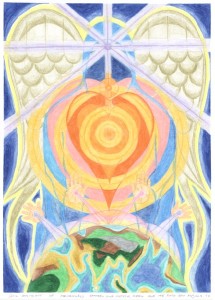Usually when we think of ourself, or reflect on the question “Who am I?” it seems as if there is some form of permanent, fixed, singular self that is there somewhere inside us that remains the same no matter what. However, if we look and observe a little more deeply we start to see that there are many different “selves” that we feel and experience at different times in our daily life according to what is going on, and each of these selves has a very different feel and nuance to it. There are many different ways in which you can begin to categorize these different senses of self, in this article I want to focus on three main ones:
- Our personal self-sense, or our “i-self sense”
- Our interpersonal self-sense, or “we-self sense”
- Our transpersonal self-sense or “I-self sense”
Let’s look at these one at a time:
1. Our personal self-sense or “i-self sense”
This is the many different self-senses that we develop as a person-ality. For example it is that sense of self that we develop when we think (taking a fictional character “Mark” as an example):
- “ My name is Mark and I am a corporate strategist”
- “My name is Mark and I went to X school and collage”
- “ My name is Mark and I am a extroverted, talkative personality type”
- “ My name is Mark and I am happy when X happens”
- My name is Mark and I cannot stand this type of person”
With each of these different statements about himself, Mark will come a different self-sense, a different “I” so to speak, each of them unique.
Like Mark, all of us have many unique self-senses on this level.
2. Our interpersonal self-sense, or “we-self sense”
This is the self-sense that is generated within ourselves whenever we are with someone else. If you observe your self-sense closely, you will see that, with each person you know, there is a unique sense of self that you feel whenever you are with them, and this self-sense is never repeated in exactly the same way with anyone else. It is almost as if a unique self-sense is created within us with every single relationship we have ever had.
To take the example of our fictional character Mark, Mark has a different sense of self when he is with his mother, his father, his siblings, his lovers, his child, his colleagues, his sport and recreation partners and so on.
We generate many, many “we-self senses” in our relationships with others.
3. Our transpersonal self-sense, or “I-self sense”
Our transpersonal self sense I call our “I(capital I)-self sense because it is the sense of self that we develop when we develop a sense of self that is beyond the boundaries of our ordinary self-sense, ego or personality. For example it is the sense of self that we touch on in deeper meditation, when we experience a tangible connection to the Universe and all living beings. Many people have also had “peak-expereinces” or temporary heightened states of consciousness where their sense of self expands to feel as if it is Universal. We can also develop an profound temporary “I-sense” when listening to music, or interacting with beautiful art.
One of the main aims of meditation is to develop a consistent experience of this “Universal Self” or “I-self sense”. Our “I-sense” is one basic way of understanding what our Enlightened Self, or True Self is.
So, what is the use of thinking and reflecting upon all our “self-senses??
“Who am I” is one of the perennial questions that people have been asking in meditation for millennia, some of the benefits of getting practically acquainted with the three types of self sense mentioned above includes:
- Understanding that your self-sense is not fixed and permanent. This means that if there is something that you don’t like about the way you view yourself, you can learn to change it for the better
- You can focus on the self-senses that are positive and beneficial to you, and learn to consciously release and let go of self senses that do not actively serve you and your happiness
- Each time you reflect on your self-sense you develop more self knowledge
- You begin to articulate what your True-self or Spiritual self really is.
One minute meditation on the three self-senses
After reading the above article:
Sit down, take a couple of deeper breaths, relax your body and mind.
Let your breathing return to normal. As you breath reflect on how your “i-sense” feels right now, the I you feel as a person-ality.
Then think of a social interaction that you have engaged in, observe for a short while the “we-self sense” that you have developed in relation to another person or people.
Finally let your mind become as open, relaxed and spacious as possible. For a short while observe your “I-sense”, the sense of self that arises when your consciousness is clear, open and expansive.
Finish.
If you do this exercise once a day for the next week, you will begin to get a practical feel for these three I self-senses, and how you can use them for the better in your life.
Thanks for reading,
Yours in the spirit of the journey,
Toby







